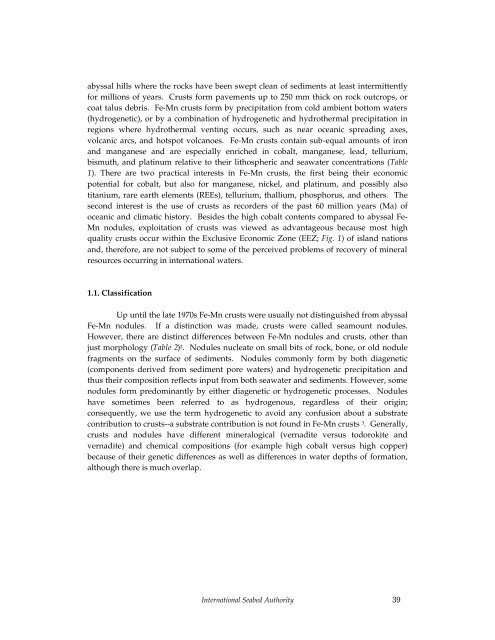Full page fax print - International Seabed Authority
Full page fax print - International Seabed Authority
Full page fax print - International Seabed Authority
Create successful ePaper yourself
Turn your PDF publications into a flip-book with our unique Google optimized e-Paper software.
abyssal hills where the rocks have been swept clean of sediments at least intermittently<br />
for millions of years. Crusts form pavements up to 250 mm thick on rock outcrops, or<br />
coat talus debris. Fe-Mn crusts form by precipitation from cold ambient bottom waters<br />
(hydrogenetic), or by a combination of hydrogenetic and hydrothermal precipitation in<br />
regions where hydrothermal venting occurs, such as near oceanic spreading axes,<br />
volcanic arcs, and hotspot volcanoes. Fe-Mn crusts contain sub-equal amounts of iron<br />
and manganese and are especially enriched in cobalt, manganese, lead, tellurium,<br />
bismuth, and platinum relative to their lithospheric and seawater concentrations (Table<br />
1). There are two practical interests in Fe-Mn crusts, the first being their economic<br />
potential for cobalt, but also for manganese, nickel, and platinum, and possibly also<br />
titanium, rare earth elements (REEs), tellurium, thallium, phosphorus, and others. The<br />
second interest is the use of crusts as recorders of the past 60 million years (Ma) of<br />
oceanic and climatic history. Besides the high cobalt contents compared to abyssal Fe-<br />
Mn nodules, exploitation of crusts was viewed as advantageous because most high<br />
quality crusts occur within the Exclusive Economic Zone (EEZ; Fig. 1) of island nations<br />
and, therefore, are not subject to some of the perceived problems of recovery of mineral<br />
resources occurring in international waters.<br />
1.1. Classification<br />
Up until the late 1970s Fe-Mn crusts were usually not distinguished from abyssal<br />
Fe-Mn nodules. If a distinction was made, crusts were called seamount nodules.<br />
However, there are distinct differences between Fe-Mn nodules and crusts, other than<br />
just morphology (Table 2) 2. Nodules nucleate on small bits of rock, bone, or old nodule<br />
fragments on the surface of sediments. Nodules commonly form by both diagenetic<br />
(components derived from sediment pore waters) and hydrogenetic precipitation and<br />
thus their composition reflects input from both seawater and sediments. However, some<br />
nodules form predominantly by either diagenetic or hydrogenetic processes. Nodules<br />
have sometimes been referred to as hydrogenous, regardless of their origin;<br />
consequently, we use the term hydrogenetic to avoid any confusion about a substrate<br />
contribution to crusts--a substrate contribution is not found in Fe-Mn crusts 3. Generally,<br />
crusts and nodules have different mineralogical (vernadite versus todorokite and<br />
vernadite) and chemical compositions (for example high cobalt versus high copper)<br />
because of their genetic differences as well as differences in water depths of formation,<br />
although there is much overlap.<br />
<strong>International</strong> <strong>Seabed</strong> <strong>Authority</strong> 39

















